In the west we think of headhunters as people who help you find your next job. Headhunting in Myanmar is entirely different vocation. Until just over 30 years ago the practice of headhunting (hunting victims, severing their heads and using them as trophies/religious icons) was alive and well. Two of the peoples we will be contacting on our trek are former headhunters, the Naga and the Wa.
The Wa, were historically and are presently a very insular group living deep in the hills and mountains of the Shan State. In the past the Was rarely left their well hidden village unless it was on an organized head hunting expedition. Headhunting for the Was was a part of their religion and cultural belief system. They believed that the captured skulls warded off evil spirits and offered their communities protection. Without a the spiritual defense of a skull the Was believed that their families would die and their crops would fail to prosper thus, headhunting was ingrained as a necessary part of their tribe’s survival. So where did they get these skulls? It is said that Wa hunters particularly treasured the skulls of strangers as they believed the lost souls would stay with their decapitated heads as they’d be unable to find their way out of deep web of mountainous forest land.
The Naga people are known as fierce warriors who have fought off both British and Burmese government troops in the past. Nagas, like Was used the decapitated heads as a means of village protection, but they also capitilized on headhunting as a path through which men gained personal recognition and glory for their families and villages. Naga hunters decapitated their victims and hung their heads in baskets among bamboo groves with arrows through the eye-sockets which, like the puzzling landscape of the Shan State, was believed to anchor the souls of the skull which in turn provided protection over the village.
Cultural changes including the influx of Christianity and the harsh criminal penalties introduced under British colonialism have lead the practice of headhunting to dwindle into what is now believed as extinction. So how do the Was protect their villages, families, and crops? And how do the Nagas illustrate portray their hunting prowess? ...We hope to find out!

